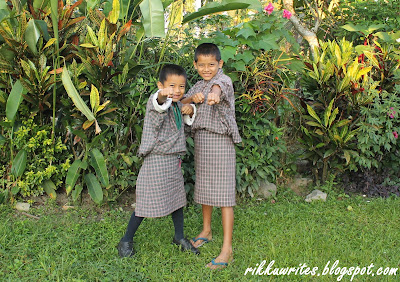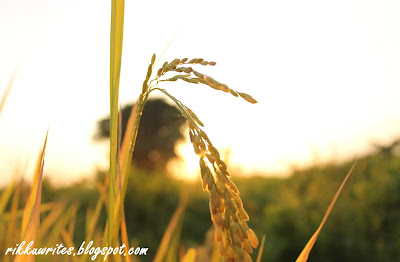The
day we have arrived in the village, my two nephews incessantly insisted on me and
my wife to visit their paddy field. We were simply astounded by their offer,
and humbly accepted it.
So
the next evening, a little before the sunset, we set out. A few
minutes’ walk from their house has brought us to the vast piece of rice land. And
once we walked in, it felt heavenly. It was filled with ripening colors of
golden paddy like a lavish gift from the God.
In
the middle of the field, the lads pressed in front of us, taking a fast stride.
And suddenly, they stopped. They raised their hands and started pointing out to
their field.
Their
voice filled with excitement and pride, they shouted, “That’s our paddy!”
It
was close to harvest, and looked very rich.
From
our family, these two lads are the only young children who are being brought up
in the village at the moment. Both go to the school: the elder one a Class I
student; and younger one is in Class PP.
We
continued our stroll, gently touching the rice and feeling its strong odor. However,
my wife and I have been left quite surprised. The young boys delighted us with
their farm knowledge. Once in the field, they no more acted like a kid.
Looking
at the rice and its color, they can assess the rice’s quality and know when
they are going to harvest their rice. So young, yet they understand the
importance of water and soil to their crops. Moreover, they know so well about
their village and households and the people who live there.
The
reality is that the children of my village, by way of life, are continuously
engaged in life and works of their parents. As they grow up, they acquire the
farming skills and knowledge as in the process.
After
half an hour, the sun sunk and we returned towards home. On the way back, my
wife asked the lads what they want to become in the future. The older one
aspires to become a teacher, and the younger one, a driver.
None
wants to be a farmer.
Hearing
it pained me. Even the children who know so well about farming do not wish to
become a farmer. I know the education will definitely take them away from here.
Will
they return and again show similar interest in their farm?
For
the first time in my life, I began to worry what future holds for this
beautiful farmland.

































